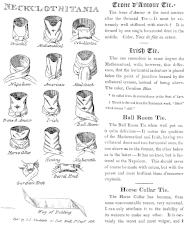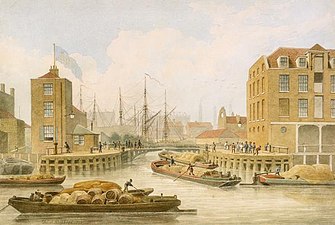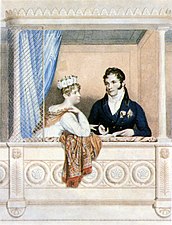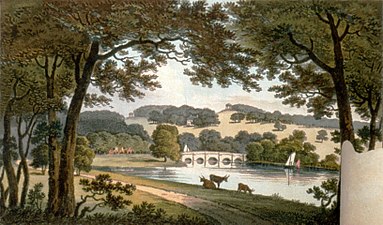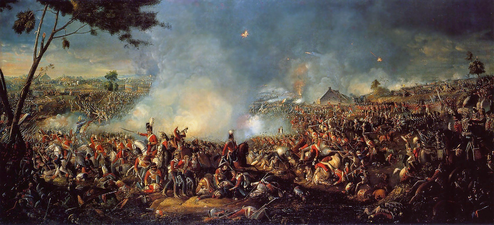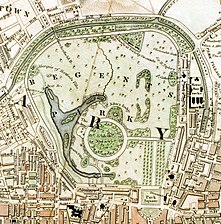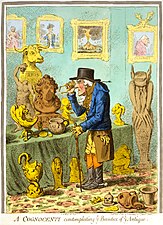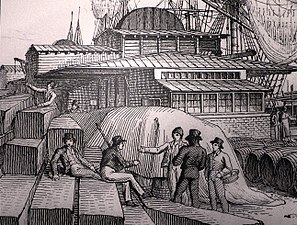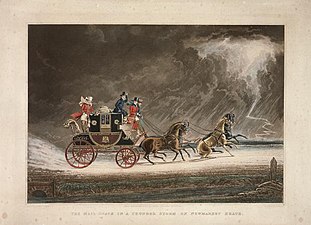Regency era
| Regency era | |||
|---|---|---|---|
| c. 1795 – 1820 (1837) | |||
George, Prince Regent[1] | |||
Chronology
| |||
| Periods in English history |
|---|
| Timeline |
The Regency era of
Although the Regency era is remembered as a time of refinement and culture, that was the preserve of the wealthy few, especially those in the Prince Regent's own social circle. For the masses, poverty was rampant as population began to concentrate due to industrial labour migration. City dwellers lived in increasingly larger
The longer timespan recognises the wider social and cultural aspects of the Regency era, characterised by the distinctive
Legislative background
In 1761, George III married Princess
The King's mental health continued to be a matter of concern but, whenever he was of sound mind, he opposed any further moves to implement a Regency Act. Finally, following the death on 2 November 1810 of his youngest daughter,
After George IV died in 1830, a further
Perceptions
Periodisation terminology
Officially, the Regency began on 5 February 1811 and ended on 29 January 1820 but the "Regency era", as such, is generally perceived to have been much longer. The term is commonly, though loosely, applied to the period from c. 1795 until the accession of
Social, economic and political counterpoints
The Prince Regent himself was one of the leading patrons of the
While the Regency is noted for its elegance and achievements in the fine arts and architecture, there was a concurrent need for social, political and economic change. The country was enveloped in the
Essentially, England during the Regency era was a stratified society in which political power and influence lay in the hands of the landed class. Their fashionable locales were worlds apart from the slums in which the majority of people existed. The slum districts were known as rookeries, a notorious example being St Giles in London. These were places where alcoholism, gambling, prostitution, thievery and violence prevailed.[14] The population boom, comprising an increase from just under a million in 1801 to one and a quarter million by 1820, heightened the crisis.[14] Robert Southey drew a comparison between the squalor of the slums and the glamour of the Regent's circle:[15]
The squalor that existed beneath the glamour and gloss of Regency society provided sharp contrast to the Prince Regent's social circle. Poverty was addressed only marginally. The formation of the Regency after the retirement of George III saw the end of a more pious and reserved society, and gave birth of a more frivolous, ostentatious one. This change was influenced by the Regent himself, who was kept entirely removed from the machinations of politics and military exploits. This did nothing to channel his energies in a more positive direction, thereby leaving him with the pursuit of pleasure as his only outlet, as well as his sole form of rebellion against what he saw as disapproval and censure in the form of his father.
The arts
Architecture
Regent's Park and London Zoo
In the 1810s, the Prince Regent proposed the conversion of Crown land in Marylebone and St Pancras into a pleasure garden. The design work was initially assigned to the architect John Nash but it was the father and son partnership of James and Decimus Burton who had the majority of input to the project.[16] Landscaping continued through the 1820s and Regent's Park was finally opened to the public in 1841.[17]
The Zoological Society of London (ZSL) was founded in 1826 by
Literature
Jane Austen, Lord Byron, Walter Scott and others were the most prominent writers of the Regency era. However, the time period also produced some of the 19th century's most prolific writers such as Charles Dickens, Charlotte Bronte, and Benjamin Disraeli.[19] Especially popular forms of literature at this time were novels and poetry, such as Lord Byron's The Regent's Bomb.[20]
Music
Wealthy households staged their own music events by relying on family members who could sing or play an instrument. For the vast majority of people, street performers provided their sole access to music of any kind. However, the upper class enjoyed music such as Ludwig van Beethoven's Piano Sonata No. 30, Felix Mendelssohn's Violin Sonata in F major, MWV Q 7, and much more.[21][22] Especially popular composers of the time included Beethoven, Rossini, Liszt, and Mendelssohn.[23]
Painting
The most prominent landscape painters were
Theatre

The plays of William Shakespeare were very popular throughout the period. The performers wore modern dress, however, rather than 16th-century costumes.[24]
London had three
Media
Among the popular newspapers, pamphlets and other publications of the era were:[citation needed]
- Ackermann's Repository
- The Gentleman's Magazine
- The Times
- The Observer
- Cobbett's Weekly Political Register
- La Belle Assemblée
Science and technology
In 1814,
Sport and recreation
Women's activities
During the Regency era and well into the succeeding Victorian era, society women were discouraged from exertion although many did take the opportunity to pursue activities such as dancing, riding and walking that were recreational rather than competitive. Depending on a lady's rank, she may be expected to be proficient in reading and writing, mathematics, dancing, music, sewing, and embroidery.
Balls
One of the most common activities among the upper class was attending and hosting balls, house parties, and more. These often included dancing, food, and gossip. The food generally served included items such as white soup made with veal stock, almonds and cream, cold meats, salads, etc.[29]
Bare-knuckle boxing

At one time, prizefighting was "anything goes" but the champion boxer Jack Broughton proposed a set of rules in 1743 that were observed throughout the Regency era until they were superseded by the London Prize Ring Rules in 1838.[30] Broughton's rules were a reaction to "bar room brawling" as they restricted fighters to use of the fists only. A round ended when a fighter was grounded and the rules prohibited the hitting of a downed opponent. He was helped to his corner and then had thirty seconds in which to "step up to the mark", which was a line drawn for that purpose so that the fighters squared off less than a yard apart. The next round would then begin. A fighter who failed to step up and square off was declared the loser. Contests continued until one fighter could not step up.[30]
There were no weight divisions and so a
Cricket
Marylebone Cricket Club, widely known as MCC, was founded in 1787 and became cricket's governing body. In 1788, the club drafted and published a revised version of the sport's rules. MCC had considerable influence throughout the Regency era and its ground, Lord's, became cricket's premier venue.[35] There were in fact three Lord's grounds. The first, opened in 1787 when the club was formed, was on the site of Dorset Square in Marylebone, hence the name of the club.[36] The lease was terminated in 1811 because of a rental dispute and the club took temporary lease of a second ground in St John's Wood.[36] This was in use for only three seasons until the land was requisitioned because it was on the proposed route of the Regent's Canal. MCC moved to a nearby site on which they established their present ground.[37]
Lord Byron played for Harrow School in the first Eton v Harrow match at Lord's in 1805.[38] The match became an annual event in the social calendar.[citation needed]
Lord's staged the first
Football
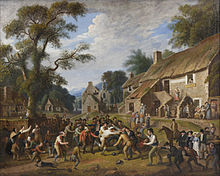
Horse racing
National Hunt racing began in 18th century Ireland and developed in England through the Regency era. There are tentative references to races held between 1792 and 1810.[43] The first definitely recorded hurdle race took place on Durdham Down, near Bristol, in 1821.[44] The first officially recognised steeplechase was over a cross-country route in Bedfordshire on 8 March 1830.[45]
Aintree Racecourse held its first meeting on 7 July 1829.[46] On 29 February 1836, a race called the Grand Liverpool Steeplechase was held. One of its organisers was Captain Martin Becher who rode The Duke to victory. The infamous sixth fence at Aintree is called Becher's Brook. The 1836 race, which became an annual event, is recognised by some as the first Grand National, but there are historical uncertainties about the three races between 1836 and 1838 so they are officially regarded as precursors to the Grand National. Some sources insist they were held on Old Racecourse Farm in nearby Maghull but this is impossible as that course closed in 1835.[47] The first official Grand National was the 1839 race.[48]
Rowing and sailing
Track and field athletics
Events
- 1811
- George Augustus Frederick, Prince of Wales,Carlton House in celebration of his assumption of the Regency. Ludditeuprisings. Glasgow weavers riot.
- 1812
- Prime Minister Spencer Perceval was assassinated in the House of Commons. The final shipment of the Elgin Marbles arrived in England. Sarah Siddons retired from the stage. Shipping and territory disputes started the War of 1812 between the United Kingdom and the United States. The British were victorious over French armies at the Battle of Salamanca. Gas company (Gas Light and Coke Company) founded. Charles Dickens, English writer and social critic of the Victorian era, was born on 7 February 1812.
- 1813
- Poet Laureate.
- 1814
- Invasion of France by allies led to the River Thames Frost Fair was held, which was the last time the river froze. Gas lighting introduced in London streets.

Wellington at the Battle of Waterloo - 1815
- John Loudon Macadam's road construction methodadopted.
- 1816
- Income tax abolished. A "year without a summer" followed a volcanic eruption in Indonesia. Mary Shelley wrote Frankenstein. William Cobbett published his newspaper as a pamphlet. The British returned Indonesia to the Dutch. Regent's Canal, London, phase one of construction. Beau Brummellescaped his creditors by fleeing to France.
- 1817
- Captain Blighdied.
- 1818
- Queen Charlotte died at Kew. Manchester cotton spinners went on strike. Riot in Stanhope, County Durham between lead miners and the Bishop of Durham's men over Weardale game rights. Piccadilly Circus constructed in London. Frankenstein published. Emily Brontë born.
- 1819
- Sir Stamford Raffles, a British administrator, founded Singapore. First steam-propelled vessel (the SS Savannah) crossed the Atlantic and arrived in Liverpool from Savannah, Georgia.
- 1820
- Death of George III and the accession of The Prince Regent as George IV. The House of Lords passed a bill to grant George IV a divorce from Queen Caroline, but because of public pressure, the bill was dropped. John Constable began work on The Hay Wain. Cato Street Conspiracy failed. Royal Astronomical Society founded. Venus de Milo discovered.
Places
The following is a list of places associated with the Regency era:[54]

- The Adelphi Theatre[55]
- Almack's
- Angelo's, a fencing parlor
- Argyll Rooms
- Astley's Amphitheatre
- Attingham Park[56]
- Bank of England
- Bath, Somerset[57]
- Bond Street
- Brighton Pavilion
- Brighton and Hove
- Brooks's
- Burlington Arcade
- Bury St Edmunds
- Carlton House, London
- Chapel Royal, St. James's
- Cheltenham, Gloucestershire[58]
- Circulating libraries, 1801–1825[59]
- Covent Garden
- Custom Office, London Docks
- Doncaster Races[60]
- Drury Lane
- Floris of London
- Fortnum & Mason
- Gretna Green[61]
- Gentleman Jackson's Saloon, a pugilist's parlor by bare-knuckle champion John Jackson
- Hatchard's
- Little Theatre, Haymarket
- Her Majesty's Theatre
- Hertford House
- Holland House
- Houses of Parliament
- Hyde Park, London
- Jermyn Street
- Kensington Gardens[62]
- King of Clubs
- Lansdowne House
- List of gentlemen's clubs in London
- Lloyd's of London
- London Docks
- London Institution
- London Post Office[61]
- Lyme Regis
- Marshalsea, closed in 1811, new site opened in 1811 where White Lion Prison had been. Primarily a debtors' prison, also housed seditionists and political prisoners
- Mayfair, London
- Newgate Prison
- Newmarket Racecourse
- The Old Bailey
- Old Bond Street
- Opera House[63]
- Pall Mall, London
- The Pantheon
- Ranelagh Gardens
- Regent's Park
- Regent Street
- Royal Circus[63]
- Royal Opera House
- Royal Parks of London
- Rundell and Bridge jewellery firm
- Savile Row
- Somerset House
- St George's, Hanover Square
- St. James's
- Sydney Gardens, Bath[62]
- Temple of Concord, St. James's Park
- Tattersalls
- The Thames Tunnel
- Tunbridge Wells
- Vauxhall Gardens
- West End of London
- Watier's
- White's
Notable people





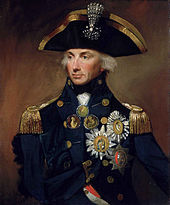

For more names see Newman (1997).[64]
- Rudolph Ackermann
- Arthur Aikin
- Henry Addington, 1st Viscount Sidmouth
- William Arden, 2nd Baron Alvanley
- Elizabeth Armistead
- Jane Austen
- Charles Babbage
- Joseph Banks
- Richard Barry, 7th Earl of Barrymore
- William Blake
- Beau Brummell
- Mary Brunton
- Lord Frederick Beauclerk
- Henrietta Ponsonby, Countess of Bessborough
- Marguerite Gardiner, Countess of Blessington
- Junius Brutus Booth
- Bow Street Runners
- Marc Isambard Brunel
- Caroline of Brunswick
- Frances Burney
- James Burton
- Decimus Burton
- Lord Byron
- George Campbell, 6th Duke of Argyll
- Robert Stewart, Viscount Castlereagh
- George Canning
- George Cayley
- Georgiana Cavendish, Duchess of Devonshire
- Princess Charlotte Augusta of Wales
- John Clare
- William Cobbett
- Samuel Taylor Coleridge
- Patrick Colquhoun
- John Constable
- Elizabeth Conyngham, Marchioness Conyngham
- Tom Cribb
- George Cruikshank
- John Dalton
- Humphry Davy
- John Disney
- David Douglas
- Maria Edgeworth
- Pierce Egan
- Thomas Bruce, 7th Earl of Elgin
- Grace Elliott
- Maria Fitzherbert
- Elizabeth Fry
- David Garrick
- George IV of the United Kingdom, Prince of Wales, Prince Regent then King
- James Gillray
- Frederick Robinson, 1st Viscount Goderich
- William Grenville, 1st Baron Grenville
- Charles Grey, 2nd Earl Grey
- Emma, Lady Hamilton
- William Harcourt, 3rd Earl Harcourt
- Ann Hatton
- William Hazlitt
- William Hedley
- Leigh Hunt
- Isabella Ingram-Seymour-Conway, Marchioness of Hertford
- Washington Irving
- John Jackson
- Edward Jenner
- Sarah, Countess of Jersey
- Dorothea Jordan
- Edmund Kean
- Charles Kemble
- John Philip Kemble
- Stephen Kemble
- Michael Kelly
- John Keats
- Lady Caroline Lamb
- Charles Lamb
- Emily Lamb, Countess Cowper
- Sir Thomas Lawrence, PRA
- Princess Lieven
- Mary Linwood
- Robert Jenkinson, 2nd Earl of Liverpool
- Hudson Lowe
- Ada Byron Lovelace
- William Macready
- John Loudon McAdam
- Lord Melbourne
- Thomas Moore
- Hannah More
- John Nash
- Horatio Nelson, 1st Viscount Nelson
- Elizabeth O'Neill
- George Ormerod
- Henry Paget, 1st Marquess of Anglesey
- Thomas Paine
- John Palmer, Royal Mail
- Sir Robert Peel
- Spencer Perceval
- William Pitt the Younger
- Jane Porter
- Hermann, Fürst von Pückler-Muskau
- Thomas De Quincey
- Thomas Raikes
- Humphry Repton
- Samuel Rogers
- Thomas Rowlandson
- James Sadler
- Walter Scott
- Richard "Conversation" Sharp
- Martin Archer Shee
- Percy Bysshe Shelley
- Mary Shelley
- Richard Brinsley Sheridan
- Sarah Siddons
- John Soane
- Adam Sedgwick
- Robert Stewart, Viscount Castlereagh
- John Wedgwood
- Arthur Wellesley, 1st Duke of Wellington
- Richard Wellesley, 1st Marquess Wellesley
- Amelia Stewart, Viscountess Castlereagh
- Thomas Telford
- Benjamin Thompson, Count Rumford
- Joseph Mallord William Turner
- Henry Vassall-Fox, 3rd Baron Holland
- Benjamin West
- William Wilberforce
- William Hyde Wollaston
- Mary Wollstonecraft
- William Wordsworth
- Jeffry Wyattville
- Thomas Young
Gallery
-
"Neckclothitania", 1818
-
Astley's Amphitheatre, 1808–1811
-
Brighton Pavilion, 1826
-
Carlton House, Pall Mall, London
-
Vauxhall Gardens, 1808–1811
-
Church of All Souls, architect John Nash, 1823
-
Regent's Canal, Limehouse, 1823
-
Frost Fair, Thames River, 1814
-
The Piccadilly entrance to the Burlington Arcade, 1819
-
Princess Charlotte Augusta of Wales and Prince Leopold of Saxe-Coburg-Saalfeld, 1817
-
Morning dress, Ackermann, 1820
-
Water at Wentworth, Humphry Repton, 1752–1818
-
Hanover Square, Horwood Map, 1819
-
Beau Brummell, 1805
-
Battle of Waterloo, 1815
-
Almack's Assembly Room, 1805–1825
-
Balloon ascent, James Sadler, 1811
-
The Anatomist, Thomas Rowlandson, 1811
-
Regent's Park, Schmollinger map, 1833
-
100 Pall Mall, former location of National Gallery, 1824–1834
-
Cognocenti, Gillray Cartoon, 1801
-
Custom Office, London Docks, 1811–1843
-
Customs and Excise, London Docks, 1820
-
Mail coach, 1827
-
Assassination of Spencer Perceval, 1812
-
The pillory at Charing Cross, Ackermann's Microcosm of London, 1808–1811
-
Covent Garden Theatre, 1827–28
See also
- Regency architecture
- Regency fashions
- Regency dance
- Régence, the period of the early 18th-century regency in France
- Society of Dilettanti
- Era of Good Feelings, for The United States
References
- ISBN 978-0-5215-6350-5.
- ^ a b Royal Central. The Regency before the 20th century by Lydia Starbuck. 10 March 2021.
- ^ Herman, N. (2001). Henry Grattan, the Regency Crisis and the Emergence of a Whig Party in Ireland, 1788-9. Irish Historical Studies, 32(128), 478–497. [1].
- ^ "No. 16451". The London Gazette. 5 February 1811. p. 227.
- ^ Innes (1915), p. 50.
- ^ Innes (1915), p. 81.
- ^ Royal Central. The primogeniture paradox: the posthumous heir. 3 October 2015.
- ISBN 978-1-4766-4238-3.
- ^ Plunkett, John; et al., eds. (2012). Victorian Literature: A Sourcebook. Houndmills, Basingstoke: Palgrave Macmillan. p. 2.
- ^ Sadleir, Michael (1927). Trollope: A Commentary. Constable & Co. pp. 17–30.
- ^ from the original on 30 October 2017. Retrieved 23 May 2017.
- ^ Parissien, Steven. (2001). George IV: Inspiration of the Regency, p. 117. New York: St. Martin's Press.
- May, Thomas Erskine (1895). The Constitutional History of England Since the Accession of George the Third, 1760–1860. Vol. 1. pp. 263–364.
- ^ a b Low, Donald A. (1999). The Regency Underworld, page x. Gloucestershire: Sutton.
- ^ Smith, E. A., George IV, page 14. Yale University Press (1999).
- ISBN 978-0-3043-1561-1.
- ^ Encyclopaedia Britannica. Article on Regent's Park. Retrieved 30 June 2022.
- ^ a b "ZSL's History". Zoological Society of London. Archived from the original on 28 February 2008. Retrieved 1 July 2022.
- ^ "20 novels that shaped the Victorian era". www.penguin.co.uk. 30 August 2021. Retrieved 5 March 2024.
- JSTOR 24396032.
- ISBN 978-0-393-30091-8.
- ISBN 978-0-19-511043-2.
- ^ "A Walk Through The Regency Era - Wentworth Woodhouse %". Wentworth Woodhouse. Retrieved 5 March 2024.
- ^ Tapley, Jane. Jane Austen’s Regency World Magazine, volume 17, page 23.
- ^ Morgan, Marjorie. (1994). Manners, Morals, and Class in England, 1774–1859, p. 34. New York: St. Martin's Press.
- ISBN 978-0-6312-1877-7.
- ISSN 0305-4985.
- ^ A History of Women in Sport Prior to Title IX. Richard C. Bell (2018). The Sport Journal. United States Sports Academy.
- ^ "A Walk Through The Regency Era - Wentworth Woodhouse %". Wentworth Woodhouse. Retrieved 5 March 2024.
- ^ a b c d Encyclopaedia Britannica. The Bare-knuckle Era. Retrieved 3 July 2022.
- ^ "The Cyber Boxing Zone Encyclopedia presents The Bare Knuckle Heavyweight Champions of England". Cyber Boxing Zone. Retrieved 2 July 2022.
- ^ Miles, Henry Downes (1906). Pugilistica: the history of British boxing containing lives of the most celebrated pugilists. Edinburgh: John Grant. pp. 182–192. Retrieved 2 July 2017.
- ^ Pierce Egan, Boxiana, Volume I (1813).
- ^ Snowdon, David (2013). Writing the Prizefight: Pierce Egan's Boxiana World.
- Warner, Pelham(1946). Lord's 1787–1945. Harrap. pp. 17–18.
- ^ a b Warner, p. 18.
- ^ Warner, p. 19.
- ^ Williamson, Martin (18 June 2005). "The oldest fixture of them all: the annual Eton vs Harrow match". Cricinfo Magazine. London: Wisden Group. Retrieved 23 July 2008.[permanent dead link]
- ISBN 978-0-415-09378-1.
- ISBN 978-0-252-06042-7.
- ISBN 978-0-7146-5249-8.
- ISBN 978-0-9516-5281-7.
- ^ Barrett, Norman, ed. (1995). The Daily Telegraph Chronicle of Horse Racing. Enfield, Middlesex: Guinness Publishing. pp. 9–12.
- ^ Barrett, p. 12.
- ^ Sporting Magazine (1830), May and July editions.
- ^ "And they're off – a brief history of Aintree racecourse and the Grand National". Age Concern Liverpool & Sefton. 9 April 2019.[permanent dead link]
- ^ "The Birth of The Grand National: The Real Story". Mutlow, Mick (15 June 2009). Thoroughbred Heritage. Retrieved 9 July 2020.
- ^ Wright, Sally (3 April 2020). "An early history of Aintree racecourse". Timeform.
- ^ "The Boat Race origins". The Boat Race Limited. Archived from the original on 7 October 2014. Retrieved 1 July 2022.
- ^ "Icons, a portrait of England 1820–1840". Archived from the original on 22 September 2007. Retrieved 2 July 2022.
- IAAF. Retrieved 2 July 2020.
- ^ Robinson, Roger (December 1998). "On the Scent of History". Running Times: 28.
- ^ "George IV (r. 1820–1830)". The Royal Household. Retrieved 12 April 2015.
- ISBN 978-0-8153-0396-1.
- ^ Nelson, Alfred L.; Cross, Gilbert B. "The Adelphi Theatre, 1806–1900". Archived from the original on 8 June 2007.
- ^ "Attingham Park: History". National Trust. Retrieved 12 April 2015.
- ^ "Roman, Regency and really nearby". The Daily Telegraph. London. 14 April 2006. Archived from the original on 11 January 2022.
- ^ Sanders, Stephanie (6 December 2013). "Explore the Regency spa town of Cheltenham". visitengland.com.
- ^ "Circulating Libraries, 1801–1825". Library History Database. Archived from the original on 14 April 2008. Retrieved 12 April 2015.
- ^ "Jane Austen: Sports". Jane's Bureau of Information. Archived from the original on 9 May 2008. Retrieved 12 April 2015.
- ^ a b "Jane Austen: Places". Jane's Bureau of Information. Archived from the original on 8 May 2008. Retrieved 12 April 2015.
- ^ a b "Jane Austen: Gardens". Jane's Bureau of Information. Archived from the original on 13 May 2008. Retrieved 12 April 2015.
- ^ a b "Jane Austen: Theatre". Jane's Bureau of Information. Archived from the original on 13 May 2008. Retrieved 12 April 2015.
- ISBN 978-0-8153-0396-1.
Sources
- Bowman, Peter James. The Fortune Hunter: A German Prince in Regency England. Oxford: Signal Books, 2010.
- David, Saul. Prince of Pleasure The Prince of Wales and the Making of the Regency. New York: Atlantic Monthly Press, 1998.
- Innes, Arthur Donald (1914). A History of England and the British Empire. Vol. 3. The MacMillan Company.
- Innes, Arthur Donald (1915). A History of England and the British Empire. Vol. 4. The MacMillan Company.
- Knafla, David, Crime, punishment, and reform in Europe, Greenwood Publishing, 2003
- Lapp, Robert Keith. Contest for Cultural Authority – Hazlitt, Coleridge, and the Distresses of the Regency. Detroit: Wayne State UP, 1999.
- Marriott, J. A. R. England Since Waterloo (1913) online
- Morgan, Marjorie. Manners, Morals, and Class in England, 1774–1859. New York: St. Martin's Press, 1994.
- Morrison, Robert. The Regency Years: During Which Jane Austen Writes, Napoleon Fights, Byron Makes Love, and Britain Becomes Modern. 2019, New York: W. W. Norton, London: Atlantic Books online review
- Newman, Gerald, ed. (1997). Britain in the Hanoverian Age, 1714-1837: An Encyclopedia. Taylor & Francis. ; 904pp; 1121 short articles on Britain by 250 experts.
- Parissien, Steven. George IV Inspiration of the Regency. New York: St. Martin's P, 2001.
- Pilcher, Donald. The Regency Style: 1800–1830 (London: Batsford, 1947).
- Rendell, Jane. The pursuit of pleasure: gender, space & architecture in Regency London (Bloomsbury, 2002).
- Richardson, Joanna. The Regency. London: Collins, 1973.
- Webb, R.K. Modern England: from the 18th century to the present (1968) online widely recommended university textbook
- Wellesley, Lord Gerald. "Regency Furniture", The Burlington Magazine for Connoisseurs 70, no. 410 (1937): 233–41.
- White, R.J. Life in Regency England (Batsford, 1963).
Crime and punishment
- Emsley, Clive. Crime and society in England: 1750-1900 (2013).
- Innes, Joanna and John Styles. "The Crime Wave: Recent Writing on Crime and Criminal Justice in Eighteenth-Century England" Journal of British Studies 25#4 (1986), pp. 380–435 JSTOR 175563.
- Low, Donald A. The Regency Underworld. Gloucestershire: Sutton, 1999.
- Morgan, Gwenda, and Peter Rushton. Rogues, Thieves And the Rule of Law: The Problem of Law Enforcement in North-East England, 1718-1820 (2005).
Primary sources
- Simond, Louis. Journal of a tour and residence in Great Britain, during the years 1810 and 1811 online
External links
- Greenwood's Map of London, 1827
- Horwood Map of London, 1792 – 1799
- Results of the 1801 and 1811 Census of London, The European Magazine and London Review, 1818, p. 50
- The Bluestocking Archive
- End of an Era: 1815–1830
- New York Public Library, England – The Regency Style
- Regency Style Furniture Archived 14 April 2021 at the Wayback Machine


